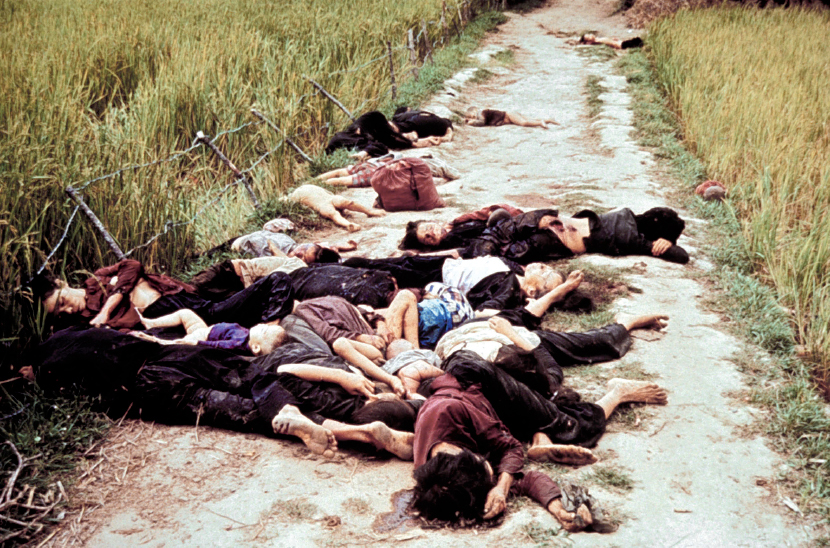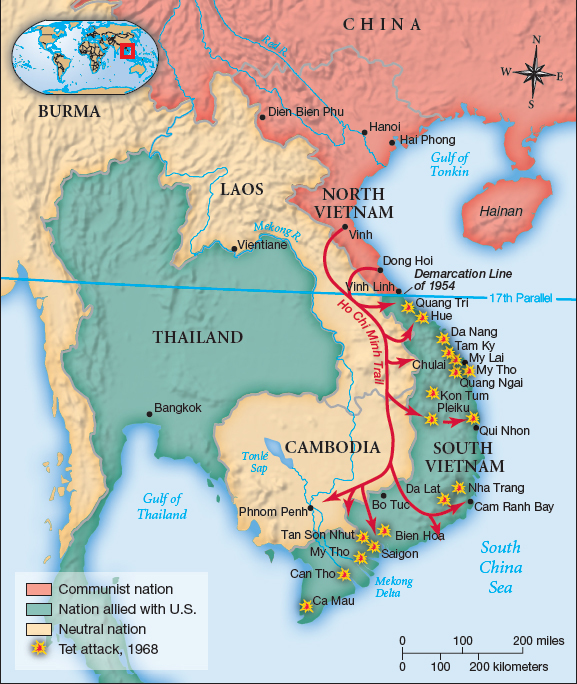Johnson Escalates the War in Vietnam
Kennedy’s successor, Lyndon B. Johnson, faced a difficult decision about Vietnam. Privately, the new president harbored reservations about fighting in Vietnam, but he was fearful of being considered soft on communism and was concerned that a demonstration of weakness would jeopardize congressional support for his domestic plans. Although President Johnson eventually concluded that more U.S. forces had to be sent to Vietnam, he hesitated to act immediately. Instead, he waited for the right moment to rally Congress and the American public behind an escalation of the war.
That moment came in August 1964. On August 2, North Vietnamese gunboats sixty miles off the North Vietnamese coast in the Gulf of Tonkin attacked an American spy ship. Two days later, another U.S. destroyer reported coming under torpedo attack, but because of stormy weather this second ship was not certain that it had actually been fired on. Neither ship suffered any damage. In fact, when informed of the assaults, the president responded: “For all I know, our navy might have been shooting at whales out there.” Despite the considerable uncertainty about what actually happened, Johnson seized the opportunity to prompt Congress to authorize military action. On August 7, with only two dissenting votes, Congress passed the Gulf of Tonkin Resolution, which empowered the president to “repel any armed attacks against the forces of the United States and to prevent further aggression.” In effect, Congress provided Johnson with unlimited power to make military decisions regarding Vietnam.
After winning election in 1964, President Johnson stepped up U.S. military action. In March 1965, with North Vietnamese forces flooding into the South, the president initiated Operation Rolling Thunder, a massive bombing campaign over North Vietnam and infiltration routes into the South along the Vietnamese borders with Cambodia and Laos, known as the Ho Chi Minh Trail. For more than three years, American planes dropped a million tons of bombs on North Vietnam, more than the total amount the United States used in World War II. Despite this massive firepower, the operation proved ineffective. A largely agricultural country, North Vietnam did not have the type of industrial targets best suited for air attacks. It stored its vital military resources underground, and the North Vietnamese were able to reconstruct rudimentary bridges and roads to maintain the flow of troops into the South within hours after U.S. bombers had pounded them.
Responding to the need to protect American air bases and the persistent ineffectiveness of the South Vietnamese government and military, Johnson deployed ever-increasing numbers of ground troops to Vietnam. In 1963, when Johnson became president, 16,000 American troops were serving in Vietnam; this number grew to 380,000 in 1966, to 485,000 in 1967, and to 536,000 in 1968, with Johnson hoping that each new infusion would be the last. An estimated 200,000 North Vietnamese reached draft age annually, and Hanoi replenished its troops to counter the U.S. escalation. The U.S. military also deployed napalm bombs, which spewed burning jellied gasoline, and Agent Orange, a chemical defoliant that denuded the Vietnamese countryside and produced long-term adverse health effects for those who came in contact with it, including American soldiers. These attacks added to the resentment of the South Vietnamese peasants living in the countryside and helped the Vietcong gain new recruits.
The United States confronted a challenging guerrilla war in Vietnam. The Vietcong fought at night and blended in during the day as ordinary residents of cities and villages. They did not provide a visible target, and they recruited women and men of all ages, making it difficult for U.S. ground forces to distinguish friend from foe. To meet this challenge, the military, under the direction of General William C. Westmoreland, established “strategic hamlets” to separate the Vietcong from noncombatants. Troops moved residents out of their villages to a new location, set up a defense perimeter around it, and assumed that anyone found outside this zone must be the enemy. Westmoreland then instituted “search and destroy” missions throughout the countryside to defeat the Vietcong. In the end, these policies did little to advance the U.S. military effort and alienated the population they were designed to safeguard.

Explore
See Document 26.2 for one American soldier’s experience in Vietnam.
On the ground, frustration also bred racism, as many American soldiers could not relate to the Vietnamese way of life and dismissed the enemy as “gooks.” Lieutenant Philip Caputo later admitted that he could order his men to burn the thatch and bamboo shacks the Vietnamese lived in because to him a “home had brick or frame walls, a window, a lawn, a TV antenna on the roof.” This attitude pushed some of the troops over the line between legitimate wartime practices and murder. Frustrated by rising casualties from an enemy they could not see, some American soldiers indiscriminately burned down villages and killed noncombatant civilians. Such disreputable behavior peaked in March 1968 with the My Lai massacre, when an American platoon murdered between 347 and 504 unarmed Vietnamese civilians in the village of My Lai.
On January 31, 1968, the Buddhist New Year of Tet, some 67,000 Communist forces mounted a surprise offensive throughout South Vietnam that targeted major population centers (Map 26.1). For six hours, a suicide squadron of Vietcong surrounded the U.S. Embassy in Saigon. U.S. forces finally repelled the Tet Offensive, but the battle proved psychologically costly to the United States. Following the Tet Offensive, the most revered television news anchor of the era, Walter Cronkite of CBS, turned against the war and expressed the doubts of a growing number of viewers when he announced: “To say that we are mired in stalemate seems the only reasonable, yet unsatisfactory conclusion.”

Tet marked the beginning of the end of the war’s escalation. On March 31, 1968, President Johnson ordered a halt to the bombing campaign and called for peace negotiations. He also stunned the nation by announcing that he would not seek reelection. By the time he left the White House in 1969, peace negotiations had stalled and some 36,000 Americans had died in combat, along with 52,000 South Vietnamese troops.
Review & Relate
|
How did President Kennedy’s domestic agenda reflect the liberal political ideology of the early 1960s? |
How and why did the United States escalate its role in the Vietnam War? |